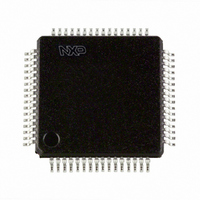SC16C554DIB64,128 NXP Semiconductors, SC16C554DIB64,128 Datasheet - Page 30

SC16C554DIB64,128
Manufacturer Part Number
SC16C554DIB64,128
Description
IC UART QUAD SOT314-2
Manufacturer
NXP Semiconductors
Datasheet
1.SC16C554DIA68512.pdf
(55 pages)
Specifications of SC16C554DIB64,128
Number Of Channels
4, QUART
Fifo's
16 Byte
Voltage - Supply
2.5V, 3.3V, 5V
With Auto Flow Control
Yes
With Irda Encoder/decoder
Yes
With False Start Bit Detection
Yes
With Modem Control
Yes
With Cmos
Yes
Mounting Type
Surface Mount
Package / Case
64-LQFP
Lead Free Status / RoHS Status
Lead free / RoHS Compliant
Other names
935270063128
SC16C554DIB64-T
SC16C554DIB64-T
SC16C554DIB64-T
SC16C554DIB64-T
Philips Semiconductors
9397 750 13132
Product data
7.6 Modem Control Register (MCR)
This register controls the interface with the modem or a peripheral device.
Table 18:
Bit
7
6
5
4
3
2
1
0
Symbol
MCR[7]
MCR[6]
MCR[5]
MCR[4]
MCR[3]
MCR[2]
MCR[1]
MCR[0]
Modem Control Register bits description
Quad UART with 16-byte FIFO and infrared (IrDA) encoder/decoder
Rev. 05 — 10 May 2004
Description
Reserved; set to 0.
IR enable.
Reserved; set to 0.
Loop-back. Enable the local loop-back mode (diagnostics). In this
mode the transmitter output (TX) and the receiver input (RX), CTS,
DSR, CD, and RI are disconnected from the SC16C554/554D I/O
pins. Internally the modem data and control pins are connected into a
loop-back data configuration (see
and transmitter interrupts remain fully operational. The Modem
Control Interrupts are also operational, but the interrupts’ sources are
switched to the lower four bits of the Modem Control. Interrupts
continue to be controlled by the IER register.
OP2, INTx enable. Used to control the modem CD signal in the
loop-back mode.
OP1. This bit is used in the Loop-back mode only. In the loop-back
mode, this bit is used to write the state of the modem RI interface
signal via OP1.
RTS
Automatic RTS may be used for hardware flow control by enabling
EFR[6]. See
DTR
Logic 0 = Enable the standard modem receive and transmit
input/output interface (normal default condition).
Logic 1 = Enable infrared IrDA receive and transmit inputs/outputs.
While in this mode, the TX/RX output/inputs are routed to the
infrared encoder/decoder. The data input and output levels will
conform to the IrDA infrared interface requirement. As such, while
in this mode, the infrared TX output will be a logic 0 during idle data
conditions.
Logic 0 = Disable loop-back mode (normal default condition).
Logic 1 = Enable local loop-back mode (diagnostics).
Logic 0 = Forces INTA-INTD outputs to the 3-State mode during
the 16 mode (normal default condition). In the loop-back mode,
sets OP2 (CD) internally to a logic 1.
Logic 1 = Forces the INTA-INTD outputs to the active mode during
the 16 mode. In the loop-back mode, sets OP2 (CD) internally to a
logic 0.
Logic 0 = Force RTS output to a logic 1 (normal default condition).
Logic 1 = Force RTS output to a logic 0.
Logic 0 = Force DTR output to a logic 1 (normal default condition).
Logic 1 = Force DTR output to a logic 0.
Table
21.
SC16C554/554D
Figure
© Koninklijke Philips Electronics N.V. 2004. All rights reserved.
8). In this mode, the receiver
30 of 55














